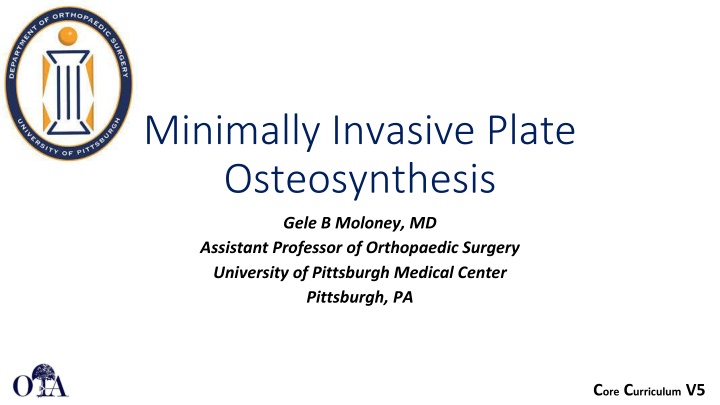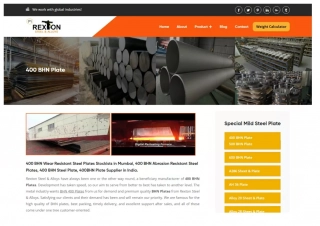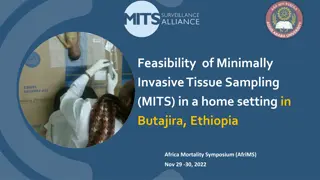Minimally Invasive Plate Osteosynthesis
Delve into the principles, limitations, and effective techniques of Minimally Invasive Plate Osteosynthesis (MIPO), a method aimed at preserving fracture site biology for improved healing. Explore the historical background, evolution of soft tissue handling, and preservation of vascularity through MIPO. Gain insights on AO Principles for fracture reduction and fixation. Discover specific fracture patterns suitable for MIPO and enhance your knowledge in orthopedic surgery.
Download Presentation

Please find below an Image/Link to download the presentation.
The content on the website is provided AS IS for your information and personal use only. It may not be sold, licensed, or shared on other websites without obtaining consent from the author.If you encounter any issues during the download, it is possible that the publisher has removed the file from their server.
You are allowed to download the files provided on this website for personal or commercial use, subject to the condition that they are used lawfully. All files are the property of their respective owners.
The content on the website is provided AS IS for your information and personal use only. It may not be sold, licensed, or shared on other websites without obtaining consent from the author.
E N D
Presentation Transcript
Minimally Invasive Plate Osteosynthesis Gele B Moloney, MD Assistant Professor of Orthopaedic Surgery University of Pittsburgh Medical Center Pittsburgh, PA Core Curriculum V5
Introduction Minimally Invasive Plate Osteosynthesis (MIPO) A mechanism of achieving plate fixation of a fracture though limited soft tissue windows with a goal of preserving fracture site biology to improve healing Note: All images belong to Gele Moloney MD unless otherwise indicated Core Curriculum V5
Objectives Understand the principles of minimally invasive plate osteosynthesis Understand the limitations of minimally invasive plate osteosynthesis Review specific fracture patterns where MIPO is safe and effective Learn technical strategies to achieve success with MIPO Core Curriculum V5
AO Principles (2017) Early and safe mobilization and rehabilitation of the injured part and the patient as a whole Fracture reduction and fixation to restore anatomical relationships Fracture fixation providing absolute or relative stability as the personality of the fracture, the patient, and the injury requires Preservation of the blood supply to soft tissues and bone by gentle reduction techniques and careful handling Core Curriculum V5 Aona.org
History Early fracture surgery often involved anatomic reduction with fixation of all fracture fragments At times this was accomplished with extensive exposure resulting in soft tissue stripping This evolved to more biologically friendly surgery and focus on preservation of periosteal blood flow Minimally invasive plating evolved from the concept of biologically friendly surgery Core Curriculum V5
Evolution of Soft Tissue Handling Open Plating with Meticulous Soft tissue handling Minimally Invasive Plating Open Plating Core Curriculum V5
MIPO preserves vascularity Cadaveric vascularity study demonstrated marked improvement in periosteal blood flow with MIPO of the distal femur compared with conventional plating (CPO) Farouk O, Krettek C, Miclau T, Schandelmaier P, Guy P, Tscherne H. Minimally invasive plate osteosynthesis: does percutaneous plating disrupt femoral blood supply less than the traditional technique? J Orthop Trauma. 1999 Aug;13(6):401- 406. jorthotrauma.com Core Curriculum V5
MIPO is: A method of applying an implant in a soft tissue friendly manner through limited incisions A technique to be used as part of a complete surgical plan MIPO isn t: Always the answer Necessarily a reduction strategy Always safe Core Curriculum V5
Minimally Invasive Reduction Techniques As always, you still need to achieve fracture reduction MIPO can be combined with open and minimally invasive or indirect reduction techniques Core Curriculum V5
Reduction Techniques: Indirect Indirect reduction with traction Intraoperative application of skeletal traction Bump under the knee to correct sagittal plane deformity Core Curriculum V5
Reduction Techniques: Indirect Intraoperative use of femoral distractor to regain length Rockwood and Green Figure 53-15 Tornetta P, Ricci WM, eds. Rockwood and Green's Fractures in Adults, 9e. Philadelphia, PA. Wolters Kluwer Health, Inc; 2019. Core Curriculum V5
Reduction Techniques: Direct Simple fracture patterns warrant direct anatomic reduction and compression Colinear clamp Pointed reduction clamps Periarticular reduction clamps Core Curriculum V5
Reduction Techniques: Combined Can use direct reduction techniques for articular surface reconstruction and minimally invasive techniques to bridge the metaphyseal component Core Curriculum V5
Direct reduction of articular surface Lateral parapatellar arthrotomy to visualize articular reduction Direct reduction utilizing shanz pins to control fracture fragments, colinear clamp to compress articular surface Core Curriculum V5
Proximal screws inserted percutaneously Bridge plating of metaphyseal component Core Curriculum V5
Cortical Screw as a Reduction Tool Cortical screw can be placed percutaneously and tightened to lateralize the shaft as needed. Core Curriculum V5
Direct Reduction Neutralization plates can also be placed minimally invasively Open approach to allow for direct reduction and lag screw placement followed by MIPO proximally Core Curriculum V5
MIPO Intraarticular Distal Femur LISS plate https://otaonline.or g/video- library/45036/proce dures-and- techniques/multime dia/16731421/liss- system-for- stabilisation-of-a- distal-femur Core Curriculum V5
MIPO Intraarticular Distal Femur https://otaonline.org/v ideo- library/45036/procedu res-and- techniques/multimedia /16731391/orif-with- submuscular-plating- of-an-intercondylar Core Curriculum V5
Distal Femur: Anatomic Concerns Superficial femoral artery averages 21 mm from the screw tips placed through a lateral plate but can be as close as 8mm. LISS plate (Less Invasive Stabilization System) holes 6-10 are highest risk. Be cautious about plunging drill bits and screws which are too long Core Curriculum V5
Distal Femur: Malreduction MIPO distal femur can result in satisfactory coronal and sagittal plane alignment > 96% of the time High risk of rotational malreduction ~50% Potential for limb length inequality ~8% Note lateral subluxation of the patella secondary to rotational malunion of the distal femur Kim JW et al Injury 2017 Core Curriculum V5 Image courtesy of G. Moloney
Distal Femur: Malreduction When viewed end on the distal femur is a trapezoid Placement of the plate too posterior or distal can cause medialization of the distal segment golf club deformity Collinge CA, Gardner MJ, Crist BD. Pitfalls in the application of distal femur plates for fractures. J Orthop Trauma. 2011 Nov;25(11):695-706. jorthotrauma.com Core Curriculum V5 JOT 2011
Proximal Tibia Plate can be slid in submuscular fashion along the anterolateral tibia with distal fixation placed percutaneously Core Curriculum V5
Limited incision with clamp and plate assisted reduction Core Curriculum V5
Distal screws placed percutaneously Core Curriculum V5
Less Invasive Stabilization System (LISS) Synthes Early MIPO system which allowed percutaneous plate insertion and use of a targeting arm to place screws Utilizes self drilling, self tapping, locked screws to create fixed angle construct internal external fixator Core Curriculum V5
LISS utilized here for open fracture with proximal fracture extension Core Curriculum V5
Difficulty removing screws secondary to cold welding of titanium screws to the plate is commonly encountered leading to lengthy and challenging hardware removal cases. Reported in almost 40% of cases! Suzuki T, Smith WR, Stahel PF, Morgan SJ, Baron AJ, Hak DJ. Technical problems and complications in the removal of the less invasive stabilization system. J Orthop Trauma. 2010 Jun;24(6):369-73. jorthotrauma.com Core Curriculum V5
Proximal Tibia: Anatomic Concerns Superficial peroneal nerve at risk during percutaneous screw placement in holes 11 through 13 of LISS plate Equates to 26-30cm from the top and should be applied to all percutaneously placed screws Consider larger open approach at that level JOT 2004 Core Curriculum V5
MIPO Proximal Tibia https://otaonline.org/vi deo- library/45036/procedur es-and- techniques/multimedia /17165314/bridge- plating-of-proximal- tibia-metaphyseal Core Curriculum V5
Distal Tibia Can be performed using limited open reduction (separate from incisions used for plate insertion) as soft tissues allow without increasing complication rates. In this series adding open reduction to percutaneous techniques alone decreased fluoro time and improved coronal plane alignment Kim JW, Kim HU, Oh CW, Kim JW, Park KC. A prospective randomized study on operative treatment for simple distal tibial fractures-minimally invasive plate osteosynthesis versus minimal open reduction and internal fixation. J Orthop Trauma. 2018 Jan;32(1):e19-e24. jorthotrauma.com Core Curriculum V5
Risk of wound infection is primary concern given limited soft tissue envelope over the medial ankle May lead to plate removal, debridement, need for flap coverage Core Curriculum V5
Distal Tibia Or you could nail it Remember, MIPO is just one option Core Curriculum V5
Humerus Multiple approaches described Technically demanding due to anatomic concerns Percutaneous screw placement unsafe over the majority of the length of the humerus Core Curriculum V5
Humerus Two limited incisions Proximal interval: deltoid/biceps Brachialis split distally Plate slid in submuscular fashion Kim JW, Kim HU, Oh CW, Kim JW, Park KC. A Prospective Randomized Study of Operative Treatment for Noncomminuted Humeral Shaft Fractures. J Orthop Trauma. 2015 Apr;29(4):189-194. jorthotrauma.com Core Curriculum V5
Humerus RCT comparing conventional plating to MIPO Union rates and complications rates equivalent Increased fluoro time with MIPO Only experienced trauma surgeons included Kim JW et al JOT 2015 Core Curriculum V5
Humerus Two limited incisions Delto-pectoral interval proximally Brachialis split distally As a percentage of humeral length measured from the lateral epicondyle: nerves most at risk during anterior approach MIPO Musculocutaneous: 18 42% Radial: 36 60% risk of A to P screws injuring the nerve Core Curriculum V5 Apivatthakakul T et al Injury 2010
MIPO Humerus: Anteromedial approach Two incisions Proximal interval: between biceps and deltoid Distal interval: elevate brachialis from medial intramuscular septum No percutaneous screws placed As a percentage of humeral length measured from the lateral epicondyle, structures most at risk during anteromedial approach MIPO Brachial Artery: 20 62% Median Nerve: 20 - 62% Musculocutaneus nerve: 20 75% Note that these danger zones span nearly the entire humerus Core Curriculum V5 Buranaphatthana T et al Injury 2019
MIPO Proximal humerus Described technique includes a limited anterolateral acromial approach/deltoid split to a point 5cm distal to the acromion (staying proximal to the axillary nerve) with percutaneous placement of distal screws using an aiming arm Would be wary of this approach as the axillary nerve crosses at the level of the calcar screws which must be placed for successful proximal humerus ORIF Core Curriculum V5
MIPO Humerus Posterior approach https://otaonline.org/video- library/45036/procedures-and- techniques/multimedia/18420128/pos terior-mipo-humerus-plating Two limited incisions Between long and lateral head of triceps proximally Radial to triceps tendon distally Can also add triceps split distally Plate slid under radial nerve Core Curriculum V5
MIPO Clavicle While MIPO clavicle can result in shorter operative times and shorter incisions, time to union is related to fracture reduction which may be more difficult to obtain via MIPO Core Curriculum V5
Distal Radius: Dorsal Spanning Plate Compares favorably to external fixation of geriatric distal radius fractures with regard to patient outcomes, complex regional pain syndrome, and infection Image courtesy of G. Moloney Wang W et al J Wrist Surg 2020 Core Curriculum V5
Distal Radius: Dorsal Spanning Plate Limited Incision localized fluoroscopically Centered between 2ndand 3rd metacarpal Dorsal aspect of the radius Deep exposure between 2nd and 3rdcompartments Superficial Radial Nerve at risk Plate slid under the extensor retinaculum which is never exposed Image courtesy of G. Moloney Core Curriculum V5
Plate can be placed on the 2nd or 3rd metacarpal 2nd metacarpal may assist in regaining radial height Core Curriculum V5
Plate can be attached to the metacarpal first and then used to regain length Core Curriculum V5
Plate removal at 3 months if bony union and patient is physiologically appropriate and desires removal Core Curriculum V5
Take Home MIPO allows insertion of plates with minimal disruption of soft tissues and can be done safely with appropriate awareness of anatomy MIPO is described for a wide variety of fractures The most widely accepted and safe locations are the distal femur, proximal tibia, and distal radius While there is literature to describe MIPO in other locations (humerus) anatomic concerns may mean the risks outweigh the potential benefits for most surgeons. Core Curriculum V5
References Farouk O et al Minimally invasive plate osteosynthesis: does percutaneous plating disrupt femoral blood supply less than the traditional technique JOT 1999 Aug;13(6):401-6 Hyatt BT et al Bridge plating for distal radius fractures in low demand patients with assist devices J Hand Surg 2019 Kim JW et al A prospective randomized study on operative treatment for simple distal tibial fractures minimally invasive plate osteosynthesis versus minimal open reduction and internal fixation JOT 2018 32:e19- e24 Kim JW et al A prospective randomized study of operative treatment for noncomminuted humeral shaft fractures: conventional open plating versus minimal invasive plate osteosynthesis JOT 2015 29:189-194 Kim JW et al A prospective randomized study of operative treatment for noncomminuted humeral shaft fractures: conventional open plating versus minimal invasive plate osteosynthesis JOT 2015 29:189-194 Toogood P et al Minimally invasive plate osteosynthesis versus conventional insertion techniques for osteosynthesis Injury 2018 Wang W et al Dorsal Bridge plating versus external fixation for distal radius fractures J Wrist Surg 2020 Core Curriculum V5























